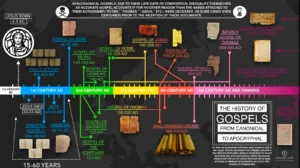Introduction
Have you ever wondered what makes an ancient document reliable? How can we know if an ancient document is accurate and to be trusted? One way is called onomastic congruence. This is the study of people’s names during the time period the writing was believed to have been written. Let’s look at the four gospels. If they were indeed written in the 1st century AD, then the names of people and places should match the frequency and accuracy of actual names in that time period.
Onomastic Congruence
PhD Candidate in New Testament, Wes Huff, released a YouTube video titled: “Onomastic Congruence – how names show the bible’s accuracy”. In the video he looks at the names of people in the four gospels. The result? They match with the actual names of people who lived in that time period and area. Some of the most common names were Simon, Joseph, Lazarus, Judas, James, John, Jesus, Jonathan and Matthew. Interestingly, when these names are used in the New Testament, they are very often used with a qualifier. Some examples are Simon called Peter; Simon the Zealot; James son of Zebedee, and John his brother; James son of Alphaeus; Matthew the Tax Collector and Judas Iscariot, who betrayed him. These people needed a qualifier such as Simon called Peter because the names were very common. Which Matthew was being referred to? Matthew the Rabbi? Matthew the baker? Or Matthew the tax collector?
Watch the YouTube video here: https://www.youtube.com/watch?v=5XVNzqFuMbQ
We can see that the more common a name is, the greater the need to qualify which John or James or Matthew or whoever is being referred to. This means that the people who wrote the gospels were using the correct names and with the correct frequency as people living in that time period and geographical area.
Fake Gospels
In contrast, the later pseudo-graphical writings do not have the correct names. Take the gospel of Judas for example. Scholars have dated it to around the 2nd or 3rd century AD. This is clearly one to hundred years after the events recorded in the gospels. One way of dating this writing is by analyzing the frequency and accuracy of names. Only two names are used that were also used in the gospels – Jesus and Judas. Just two. All the other names were popular in Egypt in the second and third centuries. Common names in the gospel of Judas are, among others, Adam, Adamas, Babelo, Eve, Dalila, Haramothoth, Nebro, Seklas, Seth, Sophia and Yaldabaoth. None of these names are found in the gospels. They were also not common in Judea and the surrounding area in the 1st century.
Conclusion
Thorough analysis of the accuracy and frequency of the names of the gospels show that the gospel writers were actually present in Israel in the first century. They used the correct names with high accuracy and knew when to qualify which particular person was being referred to, such as Matthew the Tax Collector. When analyzing the later, fake gospels, they all fail the onomastic congruence test. These writers were writing from another country entirely and used names common for that country not 1st century Israel. The high degree of onomastic congruence shows with high certainty that the bible is indeed reliable.
Read more Undoubting God blog posts here: https://undoubtinggod.com/blog/




